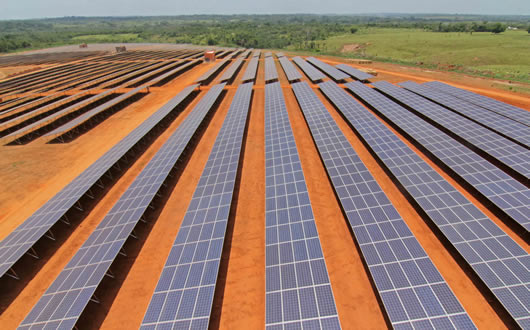Northern Chile is the region with the highest solar radiation in the world.
Photovoltaic technology was introduced in the 90s in the context of rural electrification programs.
In the area of large-scale power generation it has created in recent years a legal and economic framework that has strongly promoted its development.

The speed with which the country progressed has positioned itself as region leader, over Mexico and Brazil, in terms of growth.
Chile had 5 MW in 2012 and began 2013 with 11 MW of installed solar capacity.
The country led the region photovoltaic sector in 2014 with more than ¾ of the total. Only in the fourth quarter of that year Chile installed twice the total installed in Latin America throughout 2013.
In September 2015, 741 MW of photovoltaic energy stations were in operation, generating 131 GW/h and covering 2.3% of electricity production in the country.
A total of 2.11 GW in photovoltaic projects are under construction and green light was given for 9 other photovoltaic projects totaling 793 MW.
Together, the photovoltaic projects with environmental authorization totaled 10.33 GW by 2015.
However, the industry estimates that in 2015 only 1 MW small scale photovoltaic projects will be installed product of the entry into force of the distributed generation law.

The pessimistic diagnosis is because there are no conditions to give a true development, as with large-scale projects.
To achieve a massification of distributed photovoltaic systems is necessary to build trust with clear information; improve the categorization of authorized installers system; simplify the application, registration, change of meter and procurement process; equal rate of energy consumed with injected; facilitate access to financing.
Law 20.571 was enacted in March 2012. It was named “Net Billing” because the electricity consumed and injected are measured at different rates.
For a BT1 client means that the surplus will be assessed at 50% of the value at which buys electricity to the distribution company. This differs from the original law draft, which proposed a fee equivalent to the cost of the distribution, less 10% for administrative, billing and maintenance costs of distribution lines.
Distributed generation should really work with a law change towards a Netmetering system, following the trend of countries and states in which there have been important developments in distributed photovoltaic.
With the Net Billing current system the pay back can be more than 10 years for facilities located on RM, while with a Netmetering system could be considerably reduced.





